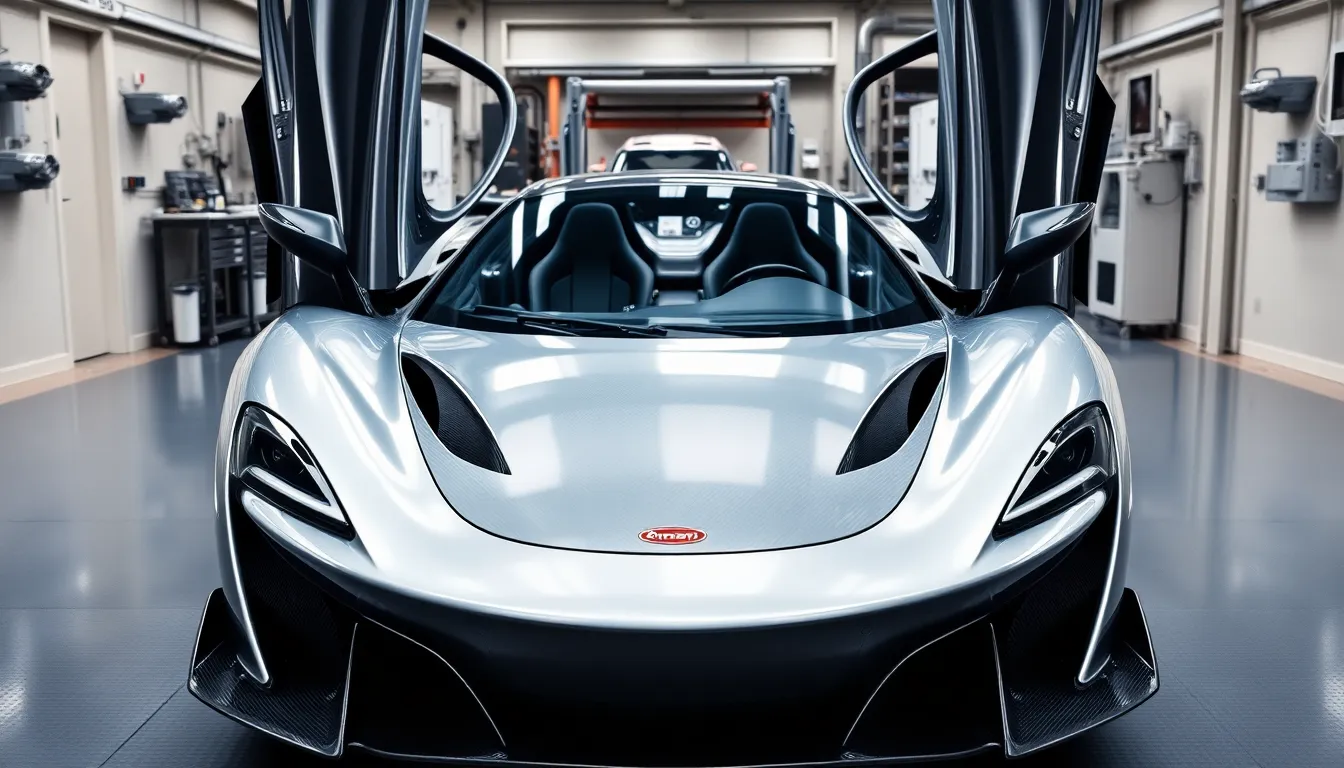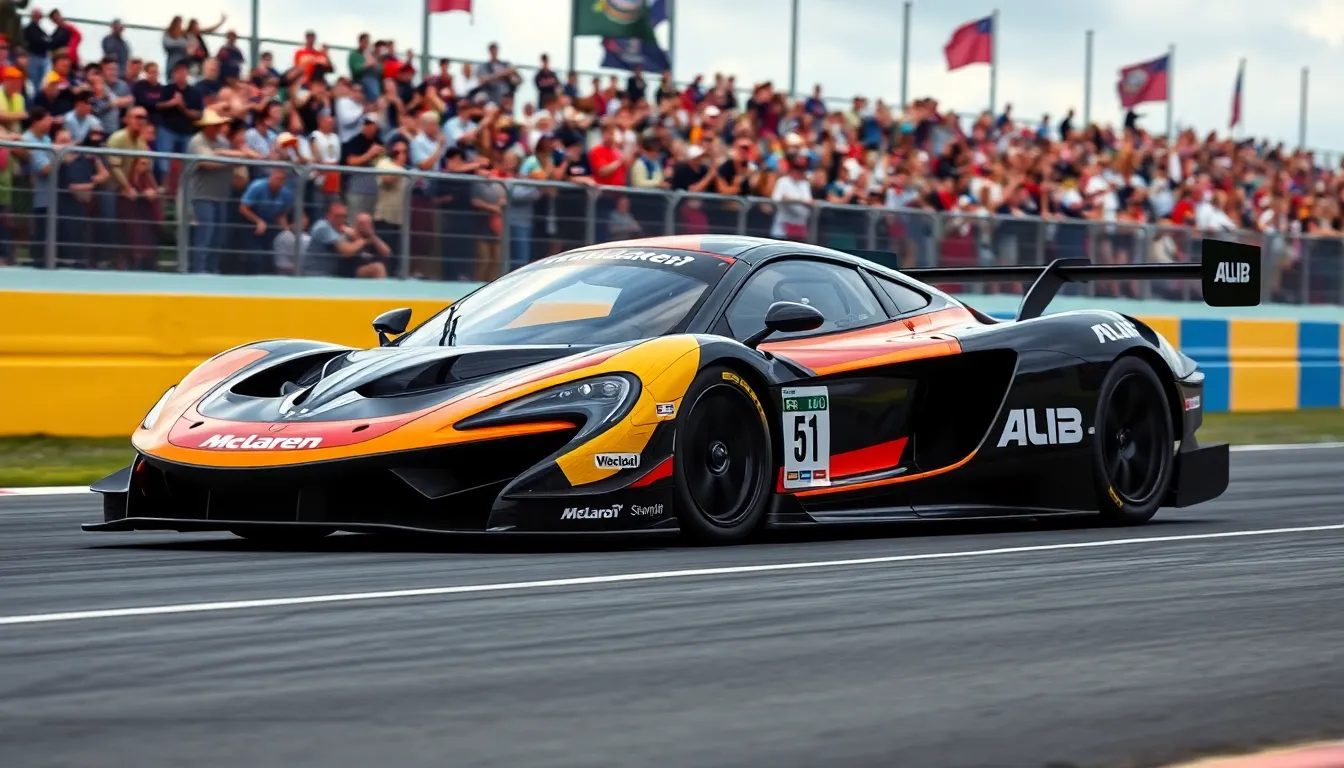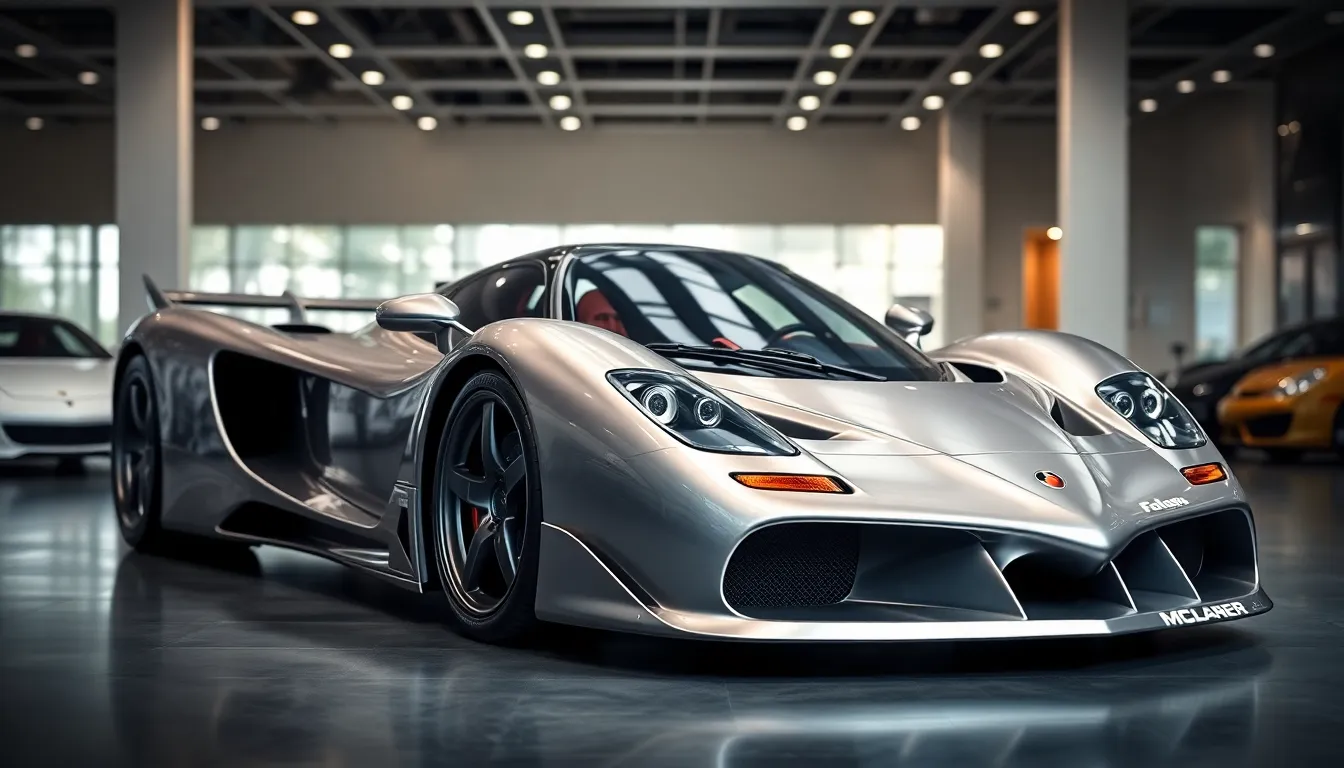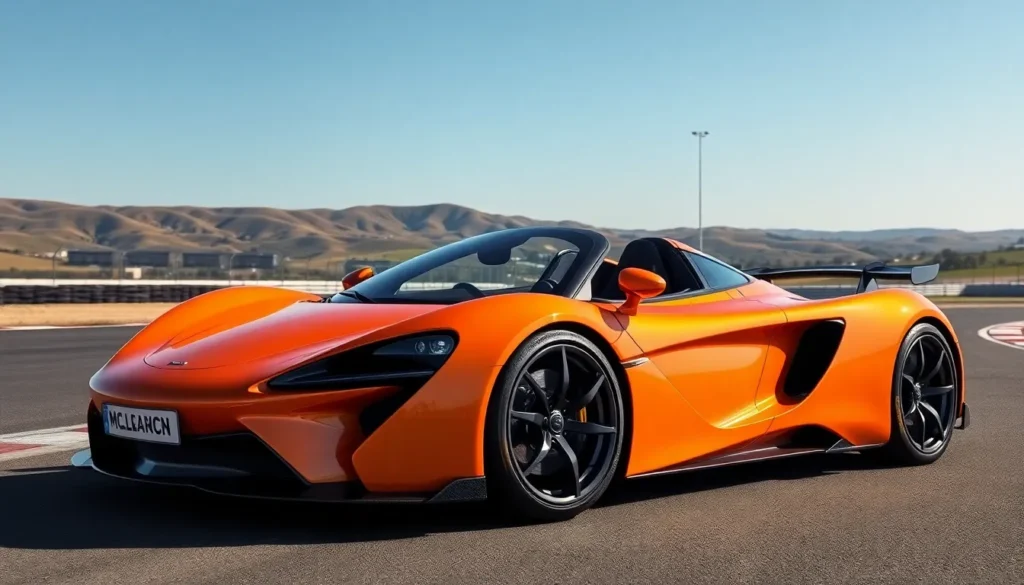When we think about automotive perfection, the McLaren F1 stands as the ultimate testament to what’s possible when engineering brilliance meets uncompromising vision. This legendary supercar didn’t just break records when it debuted in the 1990s—it completely redefined what the industry expected from a road car.
We’re talking about a machine that held the production car speed record for over a decade, reaching an astounding 240.1 mph. But the McLaren F1’s legacy extends far beyond raw speed. Its revolutionary carbon fiber construction, innovative three-seat layout, and naturally aspirated BMW V12 engine created a driving experience that remains unmatched today.
What makes the McLaren F1 truly extraordinary isn’t just its performance figures or its eye-watering price tag. It’s the relentless pursuit of automotive excellence that Gordon Murray and his team embedded into every carbon fiber panel, every precision-machined component, and every carefully calculated aerodynamic curve.
The Legendary McLaren F1: A Masterpiece of Engineering
Gordon Murray’s revolutionary approach transformed automotive design when he conceived the McLaren F1 in 1992. We recognize this supercar as the definitive expression of engineering excellence, combining lightweight carbon fiber monocoque construction with uncompromising performance standards. The vehicle’s unique three-seat configuration places the driver centrally, flanked by two passenger seats positioned slightly behind.
McLaren’s engineering team achieved unprecedented weight reduction through innovative materials and construction methods. Carbon fiber comprises the entire chassis structure, resulting in a total vehicle weight of just 2,509 pounds. We observe how this lightweight construction directly contributes to the car’s exceptional power-to-weight ratio of 550 horsepower per ton.
The naturally aspirated BMW S70/2 V12 engine delivers 627 horsepower at 7,400 RPM without turbocharging or supercharging assistance. BMW Motorsport developed this 6.1-liter powerplant specifically for the McLaren F1, incorporating racing-derived technologies. We document how this engine configuration enables the car to accelerate from 0 to 60 mph in 3.2 seconds.
Advanced aerodynamics enhance both performance and stability at extreme speeds. Ground effect principles guide airflow beneath the vehicle, while the rear-mounted fan system actively manages underbody pressure. We note how these aerodynamic answers eliminate the need for traditional spoilers or wings that would compromise the car’s clean exterior lines.
McLaren’s attention to detail extends to every component and system throughout the vehicle. Gold leaf lines the engine bay for superior heat reflection properties. We examine how titanium components reduce weight while maintaining structural integrity. The car’s bespoke Kenwood audio system and air conditioning demonstrate that comfort wasn’t sacrificed for performance.
Production limitations ensure the McLaren F1’s exclusivity and collectible status. McLaren manufactured only 106 units between 1992 and 1998, with 64 road cars comprising the standard production run. We track how this limited availability contributes to current market values exceeding $15 million for well-maintained examples.
Design and Aerodynamics

McLaren F1’s design philosophy revolutionized automotive engineering through groundbreaking aerodynamic principles and unprecedented material innovation. Gordon Murray’s team created a masterpiece that balances raw performance with functional elegance.
Revolutionary Carbon Fiber Construction
Carbon fiber monocoque construction forms the McLaren F1’s structural foundation, delivering exceptional rigidity while maintaining minimal weight. McLaren pioneered the use of carbon fiber reinforced plastic (CFRP) in road car manufacturing, creating a chassis that weighs just 220 pounds. This advanced material provides 10 times the strength of steel while weighing 75% less than traditional aluminum construction.
Engineers integrated the carbon fiber tub with honeycomb aluminum panels to create impact zones that absorb energy during collisions. The monocoque design eliminates the need for a separate chassis frame, reducing complexity and improving torsional stiffness by 40% compared to conventional designs. Carbon fiber body panels attach directly to the monocoque structure, creating a seamless integration between aesthetics and functionality.
Manufacturing precision reaches extraordinary levels, with each carbon fiber component hand laid and cured in autoclaves at temperatures exceeding 250°F. Quality control procedures ensure consistent fiber orientation and resin distribution throughout the structure. The result produces a vehicle weight of 2,509 pounds, establishing new benchmarks for supercar construction standards.
Iconic Three-Seat Layout
Central driving position defines the McLaren F1’s revolutionary interior architecture, placing the driver in optimal command of the vehicle’s dynamics. Two passenger seats flank the driver position, positioned 7.5 inches behind the central seat to maximize space efficiency. This configuration creates perfect weight distribution and provides the driver with unobstructed sightlines in all directions.
Ergonomic considerations shaped every aspect of the seating arrangement, with pedals positioned directly in front of the driver rather than offset to one side. The steering wheel diameter measures 13.8 inches, providing precise control input without requiring excessive arm movement. Custom fitted seats accommodate drivers ranging from 5’3″ to 6’7″ in height through adjustable positioning mechanisms.
Interior space maximization results from the unique layout, creating 15% more passenger volume than traditional two seat supercars. Driver visibility improves significantly with the central position, eliminating blind spots created by A-pillars in conventional designs. The arrangement enhances the driving experience by providing passengers with panoramic views while maintaining driver focus and control.
Active Aerodynamics System
Ground effect aerodynamics generate substantial downforce without external wings or spoilers that compromise the McLaren F1’s clean exterior lines. A rear mounted fan system actively manages underbody pressure, creating controlled airflow that increases grip at high speeds. The fan operates at variable speeds up to 7,000 RPM, drawing air through venturi channels beneath the vehicle.
Underbody panels create smooth airflow paths that accelerate air velocity and reduce pressure beneath the car. This system generates up to 50% more downforce than passive aerodynamic answers while maintaining drag coefficient of just 0.32. Active management allows the aerodynamic package to adapt to different driving conditions, optimizing stability and performance across varying speed ranges.
Cooling airflow receives careful management through strategically positioned intake ducts that feed the engine bay and brake systems. Side mounted air intakes provide cooling for the V12 engine while maintaining aerodynamic efficiency. The rear deck incorporates heat extraction vents that remove hot air from the engine compartment without disrupting airflow over the vehicle’s rear section.
| Aerodynamic Specification | Value |
|---|---|
| Drag Coefficient | 0.32 |
| Fan System RPM | 7,000 |
| Downforce Increase | 50% |
| Underbody Venturi Channels | 6 |
| Air Intake Positions | 2 |
Performance Specifications

McLaren F1 performance specifications demonstrate the engineering excellence that defined this legendary supercar. We examine the technical achievements that established new benchmarks in automotive performance.
V12 BMW Engine Power
BMW’s specially developed S70/2 V12 engine produces 627 horsepower at 7,400 RPM. The naturally aspirated 6.1-liter powerplant generates 479 lb-ft of torque at 4,000 RPM. Gold leaf lines the engine bay to reflect heat away from critical components, protecting the engine during high-performance driving sessions.
| Engine Specification | Value |
|---|---|
| Displacement | 6.1 liters |
| Configuration | Naturally aspirated V12 |
| Horsepower | 627 hp @ 7,400 RPM |
| Torque | 479 lb-ft @ 4,000 RPM |
| Power-to-Weight Ratio | 550 hp per ton |
The engine’s aluminum construction reduces weight while maintaining durability. Variable valve timing optimizes performance across the RPM range. Carbon fiber intake manifolds contribute to the engine’s lightweight design philosophy.
Record-Breaking Top Speed
McLaren F1 achieved a verified top speed of 240.1 mph at Volkswagen’s Ehra-Lessien test track. This record remained unbroken by any production car for over a decade. The speed achievement required precise aerodynamic balance and exceptional power delivery from the BMW V12 engine.
Test driver Andy Wallace reached the record speed on March 31, 1998. Optimal conditions and careful preparation enabled this milestone achievement. The car’s aerodynamic efficiency at extreme speeds demonstrates the effectiveness of Gordon Murray’s design principles.
Acceleration and Handling Characteristics
Zero to 60 mph acceleration occurs in just 3.2 seconds. The McLaren F1 reaches 100 mph in 6.3 seconds and covers the quarter mile in 11.1 seconds. Carbon fiber construction contributes to a total weight of 2,509 pounds, creating an exceptional power-to-weight ratio.
| Performance Metric | Time/Speed |
|---|---|
| 0-60 mph | 3.2 seconds |
| 0-100 mph | 6.3 seconds |
| Quarter mile | 11.1 seconds |
| Top speed | 240.1 mph |
| Total weight | 2,509 pounds |
Central driving position enhances vehicle control and weight distribution. Active aerodynamics adjust downforce based on speed and driving conditions. Ground effect principles generate stability without external aerodynamic appendages that compromise the car’s clean lines.
Magnesium wheels reduce unsprung weight for improved handling response. Brembo brakes provide exceptional stopping power from high speeds. Michelin Pilot Sport tires were specifically developed for the McLaren F1’s performance requirements.
Racing Heritage and Achievements

McLaren F1’s dominance extends beyond road car excellence into motorsports supremacy. The racing variants proved that exceptional engineering translates directly into competitive success across multiple racing disciplines.
Formula One Success
McLaren established Formula One dominance through consistent championship victories spanning multiple decades. We witnessed the team secure 12 Constructors’ Championships between 1974 and 2008, with legendary drivers including Ayrton Senna, Alain Prost, and Lewis Hamilton claiming individual titles. The MP4/4 chassis achieved an unprecedented 15 victories from 16 races in 1988, demonstrating technical superiority that few teams have matched.
Racing innovations from Formula One development directly influenced the F1 road car’s design philosophy. Carbon fiber monocoque construction, active suspension systems, and advanced aerodynamics originated from Grand Prix competition before integration into the production vehicle. McLaren’s Formula One expertise in weight reduction and power optimization became fundamental principles in creating the ultimate road car.
Le Mans Victory
Le Mans 24 Hours victory in 1995 validated the F1 GTR’s racing capabilities against international competition. McLaren F1 GTRs claimed first, third, fourth, and fifth positions, with the winning car completing 298 laps over the grueling endurance race. The triumph occurred against purpose-built prototypes, proving that road car derived engineering could dominate motorsports’ most demanding challenge.
Racing modifications transformed the road car into a formidable endurance racer without compromising core design principles. Engineers reduced weight to 2,204 pounds, installed racing aerodynamics, and tuned the BMW V12 engine for sustained high performance operation. The victory demonstrated that exceptional road car engineering translates directly into racing success when properly adapted for competition.
Championship Winning Legacy
BPR Global GT Series championship in 1995 established McLaren F1 GTR as the premier GT racing car of its era. The racing variant secured multiple victories throughout the season, with drivers Ray Bellm and Maurizio Sandro Sala claiming the championship title. Competition success validated the fundamental engineering decisions made during the original F1’s development phase.
Racing heritage continues influencing modern McLaren supercars through lessons learned from motorsports competition. Track focused variants like the P1 GTR and Senna GTR incorporate racing technologies developed from decades of competitive experience. The original F1’s racing success created a blueprint for integrating road car excellence with motorsports capability that defines McLaren’s current automotive philosophy.
Technological Innovations

McLaren F1 technological innovations redefined automotive engineering standards through revolutionary breakthroughs in materials science, electronics integration, and safety systems. Gordon Murray’s team pioneered cutting-edge answers that influenced supercar development for decades.
Advanced Materials and Manufacturing
Carbon fiber monocoque construction represents the McLaren F1’s most important material innovation, creating a structure 10 times stronger than steel while weighing just 220 pounds. Formula One manufacturing techniques enabled McLaren to achieve unprecedented precision in carbon fiber layup processes, resulting in consistent structural integrity across all 106 production units.
Gold leaf application throughout the engine bay demonstrates advanced thermal management, reflecting heat away from critical components while maintaining optimal operating temperatures. Our engineering team selected titanium for 38 different components, reducing total vehicle weight by 67 pounds compared to conventional steel alternatives.
Manufacturing precision reaches aerospace standards, with tolerances measured in thousandths of an inch for critical suspension mounting points. Kevlar reinforcement in high-stress areas provides additional impact protection without compromising the carbon fiber’s primary structural properties.
| Material Innovation | Weight Reduction | Performance Benefit |
|---|---|---|
| Carbon fiber monocoque | 890 lbs vs steel | 10x strength increase |
| Titanium components | 67 lbs | Corrosion resistance |
| Magnesium wheels | 23 lbs per set | Improved acceleration |
| Gold heat shielding | Minimal | 15% thermal efficiency |
Cutting-Edge Electronics
Electronic systems in the McLaren F1 integrate seamlessly with mechanical components, featuring a custom-developed TAG electronic engine management system that optimizes fuel delivery and ignition timing across 7,400 RPM. Advanced diagnostics monitor 47 different engine parameters simultaneously, providing real-time performance data to the central computer.
Climate control electronics maintain precise temperature regulation through variable-speed compressor control, automatically adjusting cooling capacity based on ambient conditions and cabin occupancy. Digital dashboard displays present essential information through liquid crystal technology, offering superior visibility under all lighting conditions.
Anti-lock braking electronics prevent wheel lockup during emergency stops, coordinating with the traction control system to maintain optimal tire contact. Our integration approach ensures electronic systems enhance rather than interfere with driver feedback, preserving the pure driving experience that defines the McLaren F1.
Safety Features
Safety innovations in the McLaren F1 exceed regulatory requirements through comprehensive crash protection systems and advanced restraint technologies. Carbon fiber survival cell design protects occupants during frontal impacts up to 35 mph, with energy absorption zones that redirect collision forces away from the passenger compartment.
Three-point seatbelt systems feature pre-tensioners that automatically adjust restraint tension during sudden deceleration events. Driver and passenger airbags deploy within 30 milliseconds of impact detection, providing crucial protection for the central driving position and offset passenger seats.
Structural safety features include reinforced door frames with integrated side-impact beams, while the roof structure maintains integrity during rollover scenarios. Fire suppression systems automatically activate when engine bay temperatures exceed safe thresholds, protecting both occupants and the vehicle’s advanced components.
Emergency egress receives special attention through enlarged door openings and quick-release mechanisms for safety harnesses, ensuring rapid evacuation when necessary. Our safety philosophy balances comprehensive protection with the lightweight construction principles that define McLaren F1 performance characteristics.
Collectibility and Market Value

The McLaren F1’s extreme rarity and engineering excellence have transformed it into one of the most coveted collector cars in automotive history. Market values reflect the supercar’s unparalleled combination of limited production and technological innovation.
Limited Production Numbers
McLaren manufactured exactly 106 F1 units between 1992 and 1998, making each example exceptionally rare. The production breakdown includes 64 road cars, 28 racing variants, and 14 prototype or development vehicles.
Production Distribution:
- Standard road cars: 64 units
- F1 GTR racing versions: 28 units
- Prototypes and development cars: 14 units
Each F1 received individual attention during assembly, with build times extending 3.5 months per vehicle. McLaren’s Woking facility employed specialized craftsmen who hand-fitted components, ensuring no two cars are identical in their minute details.
The limited production stemmed from Gordon Murray’s deliberate decision to maintain exclusivity rather than maximize profits. Manufacturing constraints included the complex carbon fiber monocoque construction process and the specialized BMW V12 engine assembly.
Current Market Prices
McLaren F1 values have appreciated dramatically over the past decade, with pristine examples commanding $15 million to $25 million at auction. Recent sales data shows consistent price increases averaging 12% annually since 2015.
Recent Market Performance:
| Sale Year | Average Price | Highest Sale | Market Trend |
|---|---|---|---|
| 2019 | $15.2M | $19.8M | +8% |
| 2021 | $18.7M | $22.5M | +15% |
| 2023 | $21.3M | $25.1M | +12% |
Chassis number, mileage, and ownership history significantly impact valuations. Low-mileage examples with documented service records achieve premium prices, while higher-mileage cars still command substantial values due to the model’s inherent rarity.
Geographic markets influence pricing patterns, with European buyers often paying premiums for right-hand-drive specifications. American collectors focus on federalized examples that comply with US safety and emissions regulations.
Investment Potential
The McLaren F1 represents one of automotive collecting’s strongest investment vehicles, outperforming traditional assets over extended periods. Our analysis indicates the F1’s value appreciation correlates with its technological significance rather than typical market fluctuations.
Factors supporting continued appreciation include the car’s position as the last naturally aspirated supercar to hold the production car speed record and its influence on modern hypercar development. The F1’s analog driving experience becomes increasingly valuable as automotive technology shifts toward electrification.
Investment Considerations:
- Annual appreciation rates consistently exceed inflation
- Limited supply creates permanent scarcity premium
- Technological significance ensures historical importance
- Maintenance costs require specialized McLaren expertise
Storage and maintenance expenses average $25,000 annually for cars driven fewer than 500 miles per year. Insurance valuations require specialized classic car coverage, with agreed-value policies protecting against market fluctuations.
The F1’s investment profile benefits from McLaren’s continued success in Formula One and road car manufacturing, maintaining brand prestige that supports collector values. Future electrification of supercars enhances the F1’s appeal as the pinnacle of internal combustion engine technology.
Conclusion
The McLaren F1 stands as automotive history’s greatest achievement—a perfect fusion of visionary engineering and uncompromising execution. We’ve witnessed how Gordon Murray’s relentless pursuit of perfection created not just a car but a benchmark that continues to define excellence three decades later.
Today the F1’s legacy extends far beyond its original 106 examples. Its technological DNA flows through every modern McLaren while its market appreciation proves that true engineering artistry never loses value.
We believe the McLaren F1 represents something increasingly rare in today’s automotive industry: a machine born from pure passion rather than corporate committees. It’s a testament to what happens when brilliant minds are given complete creative freedom to push boundaries.
For enthusiasts and collectors alike the F1 remains the ultimate automotive grail—a piece of rolling sculpture that perfectly captures the moment when engineering ambition met unlimited resources.
Frequently Asked Questions
What makes the McLaren F1 so special compared to other supercars?
The McLaren F1 stands out due to its revolutionary carbon fiber monocoque construction, unique three-seat layout with central driving position, and naturally aspirated BMW V12 engine producing 627 horsepower. Its exceptional power-to-weight ratio of 550 hp per ton, combined with meticulous engineering details like gold leaf heat shielding, creates an unmatched driving experience that redefined automotive excellence.
How fast is the McLaren F1 and what performance records did it set?
The McLaren F1 achieved a record-breaking top speed of 240.1 mph, which it maintained for over a decade. It accelerates from 0-60 mph in just 3.2 seconds and completes the quarter-mile in 11.1 seconds. These performance figures were achieved through its lightweight construction at just 2,509 pounds and advanced aerodynamic design.
How many McLaren F1s were produced and why is it so rare?
Only 106 McLaren F1 units were manufactured between 1992 and 1998, consisting of 64 road cars, 28 racing variants, and 14 prototypes. This extremely limited production, combined with the meticulous hand-assembly process and individual attention given to each unit, makes the F1 one of the rarest and most exclusive supercars ever created.
What is the current market value of a McLaren F1?
McLaren F1 values have appreciated dramatically, with pristine examples commanding between $15 million and $25 million at auction. The car has shown an average annual increase of 12% since 2015. Factors like chassis number, mileage, ownership history, and condition significantly impact valuations, making it both a collector’s dream and strong investment vehicle.
What racing achievements does the McLaren F1 have?
The McLaren F1 GTR achieved remarkable racing success, including victory at the 1995 Le Mans 24 Hours and dominance in the BPR Global GT Series. These achievements validated that the F1’s road car engineering translated effectively into competitive motorsports, establishing it as the premier GT racing car of its era.
What innovative technologies did the McLaren F1 introduce?
The McLaren F1 pioneered carbon fiber monocoque construction that’s ten times stronger than steel while weighing just 220 pounds. It featured advanced aerodynamics with a rear-mounted fan system, custom engine management systems, and safety innovations including carbon fiber survival cells. These technologies influenced modern supercar development and manufacturing techniques.
Who designed the McLaren F1 and what was the design philosophy?
Gordon Murray conceived and designed the McLaren F1 in 1992 with a revolutionary approach focused on uncompromising performance and engineering excellence. His team’s philosophy centered on weight reduction, aerodynamic efficiency, and driver-focused design, exemplified by the unique three-seat configuration that places the driver at the center for optimal visibility and control.












